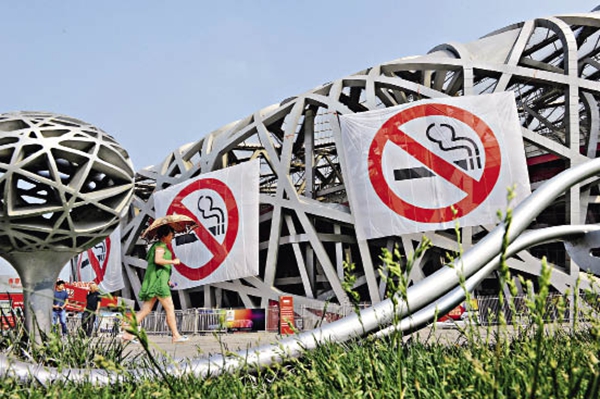By staff reporter GONG HAN
By staff reporter GONG HAN
H UGE “No Smoking” signs were put up on the Bird’s Nest, the National Stadium of Beijing, on June 1, 2015, marking the start of the city’s toughest ever smoking ban in public places, including all indoor public areas and workplaces, public transport, and a number of outdoor areas. The fine for individuals is up to RMB 200 and for owners of establishments that allow indoor smoking, up to RMB 10,000.

Huge “No smoking” signs appeared on the Bird’s Nest on June 1, 2015.
Despite its early joining of the World Health Organization Framework Convention on Tobacco Control (WHO FCTC), so far China has still not issued any national smoking control regulations. Therefore, as the city that introduced the strictest smoking ban in the country, one year after the rule was put in place, Beijing has drawn lots of attention on the results of its smoking controls.
Big Progress
“With a tobacco history of more than 400 years, China has over 300 million smokers, which has not helped promote the notion that smoking is harmful to health. So, to totally rule out indoor smoking in light of the regulation demands a process,” said Wu Yiqun, a founder of the ThinkTank Research Center for Health Development, an anti-smoking group in Beijing.
So far, 18 Chinese cities have formulated local anti-smoking regulations, and the ban in Beijing is the toughest, but also the closest to the requirements set by the WHO FCTC.
“Because of the regulations, whenever you come across someone smoking in a restaurant, you have a basis to claim your right to a smoke-free environment,” remarked Wu, who went on to explain that both workers and patrons of the restaurant would be restricted by the rule. “This is a change. If there were no regulation at all, change would not have occurred automatically,” Wu said.
Official data showed that in 2015 there were 4.19 million smokers in Beijing, accounting for 23.4 percent of the total population, which means more than 10 million people under the influence of noxious secondhand smoke.
In the months preceding the ban, Beijing residents were introduced to three gestures meaning “I mind,” “no,” and “please stop” smoking, which were featured on a poster aimed to deter smokers. The selection of the gestures was based on public opinion and repeated research.

The staff of a Beijing restaurant smash ashtrays – a move saying “no” to smoking.
The smoking ban has drawn people into heated discussions, which have been covered in media reports, and on TV and radio shows. “No Smoking” signs began to appear in all public places, like hospitals, schools, restaurants, and Internet cafés. According to a survey conducted by the Chinese Center for Disease Control and Prevention, the proportion of restaurants posting the “No Smoking” sign has shown a marked increase to 82.4 percent from the formerly 52.6 percent, and only 14.8 percent of restaurants have found diners smoking, falling from 40.3 percent.
One highlight of the Beijing smoking ban lies in the encouragement of the society participating in the smoking control drive. Anyone who spots smoking in a public place can exercise the following rights: to persuade the smoker to stop; to require the operator of the establishment to stop the smoking behavior; and to report the case to the administrative department via the anti-smoking hotline 12320. In addition, more than 13,000 volunteers have joined the smoking control drive.
What’s noteworthy is that starting from late 2013, the Chinese government required its leaders at different levels to take the lead in the “no smoking” efforts, encouraged them not to light cigarettes or smoke in public. Violators would be named and shamed or even punished.
Personal Choice Does Matter
According to a survey conducted by a third-party institution entrusted by the Beijing municipal government, in the past year, the smoking population in public places dropped to 3.8 percent from 11.3 percent. Schools, star-rated hotels, and hospitals enjoyed the best smoke-free environment, and public transport stations have experienced the biggest changes.
The public satisfaction rate towards the smoke control effect has risen to 81.3 percent from 42.26 percent. Eighty-two percent of respondents indicated their satisfaction with the implementation of the smoking ban, and 33.5 percent showed their intention to persuade smokers to stop.
Beijing’s smoking control efforts mark a big step forward for China in this regard. Dr. Bernhard Schwartländer, a WHO Representative in China, said that he was so pleased to see the smoking ban had been strictly implemented and that the general public had given great support to the ban, which thus enabled people in Beijing to enjoy fresher air. He made the remark at the anniversary celebration event for Beijing’s smoking ban, praising Beijing’s efforts in this respect.
However, there are always corners out of public sight. In May 2016, Wen Zhang, a famous actor, was exposed for smoking in the VIP room of a hot pot restaurant. Under public pressure, he apologized to the public and paid a fine. The restaurant was also fined RMB 5,000.
Some opponents to the smoking ban hold that smoking as a personal choice has nothing to do with public health. However, this opinion runs against the facts.
A 2015 survey on Chinese adults’ use of tobacco showed that China’s smoking population increased by 15 million to 316 million compared with five years ago. The non-smoking population of 740 million is suffering from the secondhand smoke and about 1.4 million die from tobacco-related diseases every year.
An adamant supporter of the smoking ban, cardiovascular and cerebrovascular disease expert Hu Dayi, observed that the number of patients needing stents to support weak arteries has been increasing. Despite the mounting number of doctors mastering the stenting technique, the demand still can’t be fully met. As an important factor to effectively reduce chronic diseases, avoiding the damaging effects of tobacco and reducing tobacco smoking is thus significant for public health. And the strict smoking ban is surely contributing to a cleaner environment.”
Lung cancer is closely related to smoking. Zhi Xiuyi, director of the Lung Cancer Diagnosis and Treatment Center affiliated to the Capital Medical University, showed a range of data: In 2015, 733,000 people were diagnosed with lung cancer and 610,000 patients died from lung cancer. In addition, more than 70 percent of lung cancer patients were diagnosed at a late stage, losing the chance for curative treatment. The average cost for advanced lung cancer treatment is already beyond RMB 110,000, which contributes to the increasingly striking social issue of poverty. Therefore, Zhi called for more attention to the medical costs incurred by smoking-related respiratory diseases and cardiovascular and cerebrovascular diseases.
A Wish for a Smoke-Free China
A third-party survey indicated that one year after the smoking ban was introduced, 46.4 percent of smokers indicated their intention to quit smoking. For that, 29 medical institutions with smoking cessation clinics have provided short-duration smoking cessation intervention in 2.92 million appointments.
Beijing’s outstanding practices in smoking control have set a good precedence and provided reference for the national legislation in this regard. However, what’s regrettable for smoking control advocates is that the suggestion for setting up designated smoking areas is quite possible to be included in the national Regulation on Smoking Control in Public Places.
For that, President of Beijing Tobacco Control Association Zhang Jianshu said bluntly in an interview with the media: “I think the revised draft of the Regulation on Smoking Control in Public Places is a regression from the first one as it endorses designated smoking areas. I think it shouldn’t be retained. Smoke dispersion is very strong. To control dispersion, a negative pressure equivalent to a grade-12 typhoon is needed. Is it possible to establish smoking areas of this type? Beijing’s Regulation on Smoking Control in Public Places is a local rule that has been best implemented and most supported by the public compared with all Beijing-issued regulations over the past several years. If the revised version becomes the final draft to be released national wide, it will be a blow to Beijing’s zeal for the ban.”
According to the WHO FCTC, there is no safety standard for secondhand smoke and specified smoking areas, which makes the suggestion for setting up smoking areas untenable.
Moreover, whether graphic warning images should be printed on cigarette packs has also become a moot point. In a comment article, People’s Daily sharply pointed out why: “It should not be ascribed to cultural and traditional factors, but to the lure of the tobacco industry’s benefits.”
It’s a global issue that tobacco enterprises stand in the way of the smoking control efforts. However, China has a special tobacco administration system: the State Tobacco Monopoly Administration is a governmental institution to propose legislation suggestions related to tobacco and to carry out smoking controls; at the same time, it also has the duty to promote the development of China’s tobacco industry. Therefore, it’s inevitable for China to swing between the two directions of smoking control on the one hand and the economic benefits of the tobacco industry on the other.
Despite the difficulty of enacting changes, smoking control is advancing. The revision of the Advertisement Law bans practically all types of tobacco ads. In addition, it clearly specifies that it’s prohibited to direct tobacco ads at teenagers. The Value Added Tax rate for cigarettes has also risen to 11 percent from 5 percent thanks to the efforts of all parties.
The tobacco industry is a typical health-harmful industry. Its contribution to the national tax revenue is far from enough to make up the costs of fixing the problems it caused. Following the national step in economic structural adjustment, the tobacco industry’s supply-side reform is underway. Measures like changing cigarette packaging and increasing the price will help to reduce tobacco consumption and, therefore, its harm to society. Thus, a smoke-free China is on the horizon.